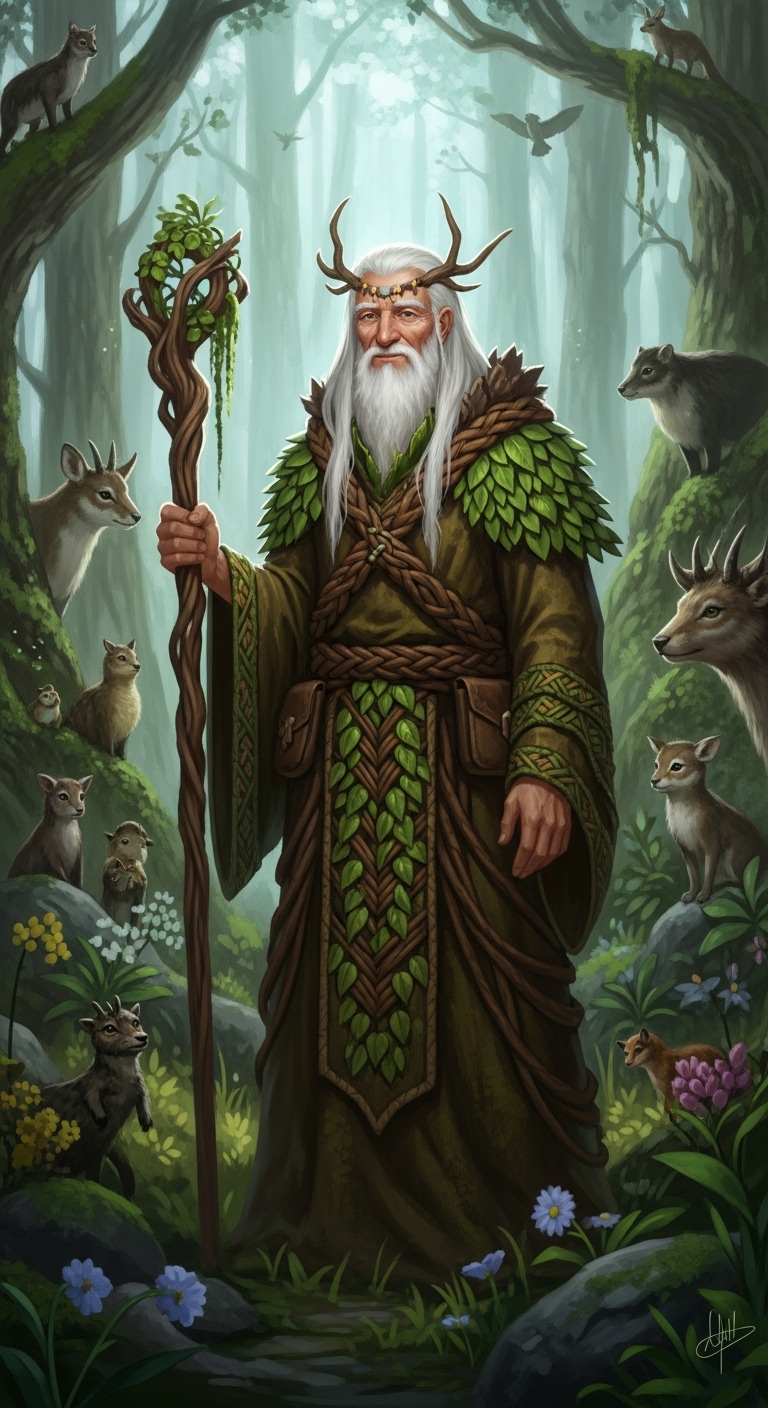Druid

- Size: Medium or Small
- Type: Humanoid (Druid)
- Alignment: Neutral
- AC: 13
- Initiative: +1 (11)
- HP: 44 (8d8+8)
- Speed: 30 ft
| ATTR | VAL | MOD | SAVE |
|---|---|---|---|
| STR | 10 | +0 | +0 |
| DEX | 12 | +1 | +1 |
| CON | 13 | +1 | +1 |
| INT | 12 | +1 | +1 |
| WIS | 16 | +3 | +3 |
| CHA | 11 | +0 | +0 |
- Skills: Medicine +5, Nature +3, Perception +5
- Gear: Studded Leather Armor
- Senses: Passive Perception 15
- Languages: Common, Druidic, Sylvan
- CR: 2 (XP 450; PB +2)
Actions
Multiattack. The druid makes two attacks, using Vine Staff or Verdant Wisp in any combination.
Vine Staff. Melee Attack Roll: +5, reach 5 ft . Hit: 7 (1d8 + 3) Bludgeoning damage plus 2 (1d4) Poison damage.
Verdant Wisp. Ranged Attack Roll: +5, range 90 ft . Hit: 10 (3d6) Radiant damage.
Spellcasting. The druid casts one of the following spells, using Wisdom as the spellcasting ability (spell save DC 13):
At Will: Druidcraft, Speak with Animals
2/Day Each: Entangle, Thunderwave
1/Day Each: Animal Messenger, Longstrider, Moonbeam
Lore & Background
Druids are guardians of nature who have dedicated their lives to preserving the balance between civilization and the natural world. These individuals have formed deep spiritual connections with the forces of nature, gaining the ability to channel primal magic and communicate with plants and animals. Druids serve as intermediaries between the civilized world and the wilderness, protecting natural areas from exploitation while helping communities coexist sustainably with their environment.
The path of the druid requires years of study and meditation in natural settings, learning to understand the complex relationships that govern ecosystems and the delicate balance that maintains natural harmony. Druids often live apart from civilization, dwelling in sacred groves, hidden valleys, or other places of natural power where they can commune with nature spirits and study the ancient wisdom of the earth.
Druid society is loosely organized around circles - groups of druids who share similar philosophies about nature and civilization. Some circles focus on protecting specific types of environments, while others dedicate themselves to particular aspects of natural magic or specific animal totems. These circles provide support networks and shared knowledge, though individual druids maintain considerable autonomy in their methods and territories.
Combat Tactics
Druids are versatile combatants who adapt their tactics to their environment and the nature of their opponents. They prefer to fight in natural settings where their magic is most effective and where they can call upon animal allies and environmental advantages. Their spellcasting provides both offensive and defensive options, while their wild shape ability allows them to take on animal forms suited to different combat situations.
These nature guardians use their intimate knowledge of local terrain to create tactical advantages, employing natural hazards, difficult terrain, and environmental effects to control the battlefield. They often begin encounters by summoning animal allies or using area effect spells to shape the engagement before closing to melee range or maintaining distance as the situation requires.
Druids are particularly effective when defending their territory, as they can use their connection to the land to predict enemy movements and prepare elaborate defenses. They coordinate well with natural creatures and may have established relationships with local wildlife that provide additional support during conflicts.
Encounter Ideas
The Territorial Guardian: A druid protects a sacred grove or natural area from encroachment, using both diplomacy and force to preserve the wilderness against civilization's expansion.
The Balance Keeper: A druid intervenes in conflicts between different communities or factions, seeking solutions that maintain ecological balance while addressing legitimate needs.
The Nature's Avenger: A druid seeks justice for environmental crimes, targeting those who have caused significant ecological damage through their actions or negligence.
The Wilderness Guide: A druid offers to guide travelers through dangerous natural areas, but their methods and priorities may conflict with the urgency of the heroes' mission.
Environmental Effects
Natural Harmony: Areas under druid protection maintain healthy ecosystems with thriving plant and animal populations.
Seasonal Awareness: Druids can predict and influence seasonal changes, weather patterns, and natural cycles within their territory.
Wildlife Networks: Animals in druid territories often serve as information gatherers and early warning systems, creating extensive natural surveillance networks.
Sacred Sites: Druids maintain and protect locations of natural power where magic is stronger and nature spirits are more active.
Treasure
Natural Remedies: Herbs, potions, and natural medicines that can cure diseases, neutralize poisons, or provide other beneficial effects.
Druidic Focuses: Staffs, wands, and other magical implements carved from sacred wood or shaped from natural materials.
Nature Lore: Scrolls and texts containing knowledge about plants, animals, weather patterns, and natural magic accumulated over years of study.
Sacred Seeds: Rare plant specimens and magical seeds that can grow into extraordinary plants with beneficial or protective properties.
Plot Hooks
The Dying Forest: A druid seeks help in discovering why a once-thriving forest is withering and dying, requiring investigation of both natural and supernatural causes.
The Circle's Schism: Different druid circles have conflicting views about how to handle a threat to nature, and their disagreement threatens to escalate into open conflict.
The Urban Druid: A druid attempts to establish a presence in a major city, seeking to create green spaces and natural balance in an urban environment.
The Ancient Pact: A druid enforces an old agreement between a community and the natural world, but changing circumstances make the original terms problematic for modern society.